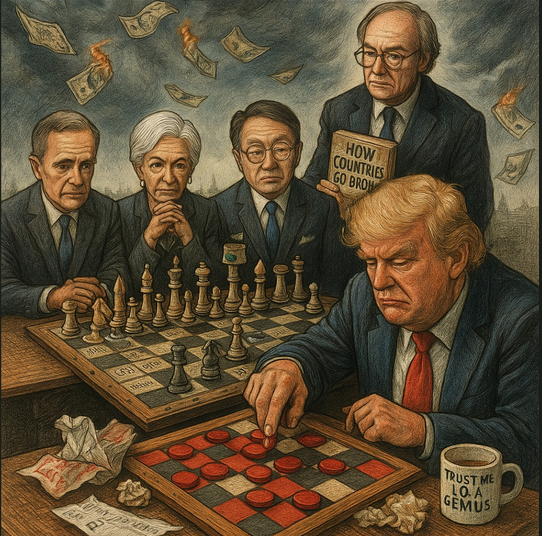There’s a reason global leaders aren’t picking up the phone
On April 16th - the highly recommended Facebook page 'Oregon's Bay Area' claimed it was feeling 'concerned'. And they are absolutely right.
Reproduced with kind permission
There’s a reason global leaders aren’t picking up the phone. While Donald Trump storms into trade wars like a jilted Monopoly tycoon with a Twitter addiction, the rest of the world is quietly reaching for the receipts.
Not just figuratively, literally. They’re holding trillions in U.S. Treasury bonds and debating how fast or how publicly to remind us who’s really cornered.
Trump’s economic chaos isn’t just bad policy. It’s an accelerant on dry tinder. The tariffs, the market manipulation, the self-serving tweets about “great times to buy DJT” hours before policy reversals, these aren’t isolated stumbles. They’re signs of a much deeper crisis unfolding: a breakdown of the postwar monetary order. The world sees it, even if Trump doesn’t.
Let’s start with the debt. One reader put it plainly: this year alone, the U.S. is on track to refinance $10 trillion of maturing debt, at more than double the interest rates of a decade ago. What we borrowed at 2% in 2015, we’re now refinancing at 4.5% or higher. That’s an extra $250 billion a year in interest. Altogether, we’ll soon be spending over $1.2 trillion annually just to service the debt, more than our entire defense budget. And that’s before Trump’s next round of tax cuts for billionaires.
You don’t have to be an economist to know what happens when you max out every credit card and then shred the bill collectors’ voicemails. You just have to read history. We’ve seen this kind of financial brinkmanship before, in 1929, in 1971, in 2008. But what we’re staring down now, as Ray Dalio warned last week on Meet the Press, could be worse than all of it.
Dalio isn’t some liberal firebrand. He founded the world’s largest hedge fund and he’s about as apolitical as they come. But his message was clear: Trump’s policies aren’t merely reckless, they’re destabilizing the very foundation of the global economy. The U.S. isn’t just flirting with a recession. We're toying with the collapse of the dollar’s role as the world’s reserve currency, the one thing that’s kept our paper empire afloat since Bretton Woods. If we lose that privilege, it’s not a downgrade. It’s a reclassification from global superpower to banana republic with nukes.
And yet, Trump struts around like he’s playing 4D chess, while the rest of the world quietly plays actual chess, with our king boxed into a corner. As Part 1 argued, Canada’s new Prime Minister Mark Carney may have orchestrated a slow, deliberate bleed of U.S. Treasury bonds in coordination with EU and Japanese allies. A financial firing squad triggered not by rage, but by risk management. In case of emergency, break the dollar.

Did Trump pause the tariffs because he saw the light? No. He blinked because the bond markets did. Because consumer sentiment collapsed to levels not seen since 1981. Because rich friends started calling. Because the Dow twitched like it knew something, and somebody absolutely did, as trade volume in ETFs like SPY and TQQQ surged just minutes before the reversal. Because Marjorie Taylor Greene somehow turned into Warren Buffett for a week, buying all the right stocks before anyone else knew the “pause” was coming.
And if you think that’s hyperbole, Senator Elizabeth Warren is already demanding investigations. She’s called out the blatant market manipulation, the suspicious trades, the suspicious silences from regulatory agencies now stacked with loyalists and sycophants. She’s also calling out what others dare not: the weaponization of economic data. Because Trump isn’t just faking his negotiating skills, he’s faking the scoreboard. Fired the economists. Hushed the statisticians. Replaced Treasury projections with “vibes.” We’re now running the economy on delusion and Doge memes.
Meanwhile, the housing market is sputtering. Not collapsing yet, but definitely wheezing. Open houses in desirable neighborhoods are drawing crickets. Mortgage rates are bouncing near 6.6% and headed higher. Builders are slashing prices and stacking incentives, even as tariffs drive up construction costs. Affordability has become a theoretical concept. The average American can no longer afford the average American home.And still, we’re told to believe everything’s fine. Trust the numbers. Trust the orange-tinted strongman with his echo chamber cabinet of billionaires and brand managers, who laugh about gutting veterans' benefits and firing teachers like it’s a Friday afternoon round of The Apprentice: Cabinet Edition.
But here’s the thing: the world isn’t stupid. They see the grift. They’ve watched the collapse of independent institutions, the politicization of data, the attacks on the judiciary, the trillion-dollar debt refinancings, the cultic belief in a man who can’t keep his lies straight through a golf round. And unlike many Americans, they’re not afraid to hedge against that madness.This is a story about trust and how quickly it can erode, and how devastating the consequences when it’s gone. When countries no longer trust our numbers. When investors no longer trust our bonds. When even allies begin quietly preparing for our decline not because they want to, but because they have to.
This is less a trade war and more of an international intervention. The world is trying to wrest the wheel from a drunk driver who thinks he’s Moses parting the Red Sea. And the passengers? That’s us. Every taxpayer. Every bondholder. Every veteran. Every teacher. Every kid whose public school is now on the chopping block so Elon Musk can tweet about fraud and fire civil servants with disabilities.
Ray Dalio sees it. Elizabeth Warren sees it. Mark Carney saw it early. And if the rest of us don’t see it soon, we may not be in a position to do much about it at all.History is watching. And the bond market is blinking red.

